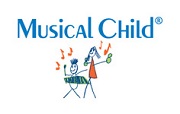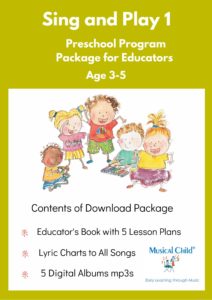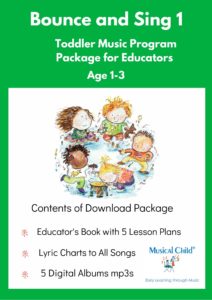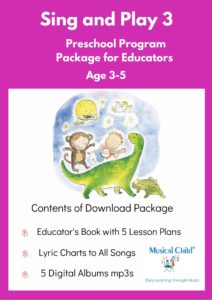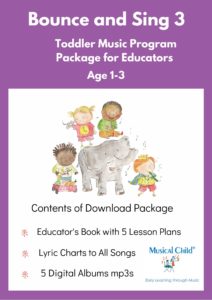There are benefits when we sing a story to preschoolers
According to some researchers I been reading recently, here is just one such benefit — ‘Story songs support meaning-making’. Educators and parents will all gain from introducing sung stories to their children, especially if they use picture books.
(If you want to learn all 10 benefits you might like to take our short course Story Songs: 10 Benefits from Sharing.)
Story songs support meaning-making
There are many ways in which children make meaning in their worlds. According to O’Rourke, meaning-making is dependent on the child’s knowledge and life experiences to date. It is highly likely that the children will relate well to the experiences we offer. We anticipate that they come to our story-songbook activity with lots of positive expectations.
According to Jalongo and McDonald Ribblett, this kind of multimedia story-time ensures richly multi-modal learning because we are providing children with a range of artistic symbol systems, visual, verbal, kinetic and musical. Note the two terms here “multi-modal” and “multimedia”. “Multi-modal learning” refers to how the child is processing information and making meaningful connections. “Multimedia experience” refers to the content we are presenting through various media including our embodied skills.
Multimedia is a term used mostly in relation to computers but it has a wider meaning. According to the Cambridge online dictionary it means “using a combination of moving and still pictures, sound, music and words especially in computers and entertainment.” However, it fits our purpose of presenting story song-based picture books. Multimedia experiences have been used to teach children important cultural knowledge since people first made marks in sand, painted ochres on bodies, bark and rock and performed masked stories in dance and song.
When thinking about a picture book experience, the first thing that probably happens is that the child looks at the image on the book cover to get an idea of what’s going on. The first mode of processing used to make meaning then is the visual. Giles and Fresne say that even if children don’t understand words that are not part of their typical life, they can infer a meaning from the illustrations and context.
Most of the meaning comes through the “performance” or what Giles and Fresne call the “readaloud” by the educator. This involves spoken and sung words, facial expressions and even the story-teller’s posture. Children also make meaning through movements. They naturally respond to the gestures and movements of the story-teller. They often become actively engaged in parts of a story that call for movement. Giles and Fresne say that movements strengthen children’s understanding of complex language and rare words, building their vocabulary. Niland reminds us that there are “natural links between music, dance, drama and literature.”
Next, it’s the music that provides the emotional ‘feel’ of the lyrics mostly through melody and rhythm. The music also cues them into changes of mood in the narrative. Another element in the music, the structure or form e.g. verse and chorus, aids their understanding of how stories are structured. Children also get another layer of meaning if there is an instrumental accompaniment to support the singer. The playing of the performers offers an intelligence of feeling to the children and adults listening.
All of these ways of communicating add rich dimensions to the meanings of the words in the story-song and carry their own non-verbal subtleties, emotional tones and significances.
In their concluding remarks Montgomery and Smith say:
“shared singing/reading with song-based picture books provided rich opportunities for families to build joyful, literacy relationships while providing kindergarten-aged children with meaningful experiences with text.” Montgomery and Smith p 27
When children are in our educational and care settings, it is their right to be offered meaningful experiences such as rich story time with song and picture book.
References
Giles, Rebecca M. and Fresne, Jeannette. Musical Stories Infusing Your Read-Alouds with Music, Movement, and Sound in Public Libraries Online Magazine Feature November 4, 2015, accessed August 20, 2019. http://publiclibrariesonline.org/2015/11/musical-stories-infusing-your-read-alouds-with-music-movement-and-sound/
Jalongo, Mary Renck and Mcdonald Ribblett, Deborah. Using Song Picture Books to Support Emergent Literacy in Childhood Education, Vol. 74, 1997.
Montgomery, Amanda P and Smith, Kathryn M. Together in Song: Building Literacy Relationships with Song-based Picture Books in Language and Literacy Volume 16, Issue 3, Special Issue 2014.
Niland, Amanda. Musical Stories: Strategies for Integrating Literature and Music for Young Children, Australian Journal of Early Childhood 32, no. 4 2007.
O’Rourke, Maureen. Multiliteracies for 21st Century Schools in The Australian National Schools Network Snapshot No. 2 May 2005.
